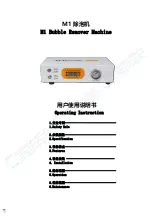
21
1600751-4D
4.3.2.d Burst Symmetrical
The burst biphasic symmetrical pulsed current is a variation to its non burst counterpart, in
which the continuous train of pulses is interrupted by pulse pauses. See fig 13.1.3.6 for details.
A burst frequency can be set for treating chronic pains, where the use of continuous stimulation
with a low pulse frequency would be too painful. Each burst lasts for 100ms and the burst rate
can separately be adjusted. With this milder TENS waveform it is easier to exceed the motorial
threshold stimulus.
Parameters:
Phase Duration
, expressed in µs,
is the elapsed time from the beginning to the termination of
the initial pulse phase. See fig 13.1.5 for details.
Phase Interval
, expressed in µs,
is the elapsed time between the positive and the negative
pulse phase. See fig 13.1.5 for details.
Pulse Frequency,
expressed in Hz or pps (pulses per second), defines the repetition rate of the
TENS pulses. See fig 13.1.5 for details.
Burst Frequency
, expressed in Hz, defines the repetition rate of bursts of pulses. A burst
consists of a train of pulses. Each burst lasts for 100 ms and the number of pulses in a burst
depends on the selected Pulse frequency i.e at a Pulse Frequency of 100Hz, 10 pulses are
available in each burst. Burst mode can not be selected when Frequency modulation is active.
See fig 13.1.3 for details.
4.3.3 Premodulated
As with Interferential currents, a medium carrier frequency is used to pass the low frequency
stimulation (beat) frequency through the skin. See fig 13.2 for the current waveform.
‘Premodulated’ implies that amplit
ude modulation occurs in the equipment, allowing it to be
applied with a single electrode pair.
The Premodulated alternating current is often used where the objective is to strengthen the
muscle and change the distribution of muscle fibers (twitch speed). The Beat frequency is used
to affect the muscle fiber distribution. The optimum carrier frequency for this purpose varies
between 2000
–
4000 Hz.
At a low Beat frequency (up to about 20 Hz) the muscle becomes ‘red’, while at a higher Beat
frequency (up to
about 150 Hz) the muscle becomes ‘white’. This can be used to increase the
explosive release of energy in high-jumpers, provided that is supplemented by functional
exercises. The most comfortable tetanic contractions are obtained at a Beat frequency between
40 and 80 Hz.
Muscle stimulation is normally applied with a Surge program, allowing the muscles to rest
between exercise cycles.
Parameters:
Carrier Frequency
, expressed in kHz, is the base frequency of the alternating current.
Beat Frequency
, expressed in Hz, defines the rate at which the amplitude is internally
modulated.
Frequency Modulation
, expressed in Hz,
defines a variable frequency range that is summed to
the Beat frequency i.e. when the Beat Frequency is set to 80 Hz and the Frequency modulation
is set to 40 Hz, the final frequency will vary from 80
–
120 Hz.
Содержание 1600905
Страница 1: ...6 series User Manual ...
Страница 3: ...6 series User Manual ...
Страница 4: ......
Страница 5: ...3 1600751 4D ...
Страница 90: ...88 1600751 4D ...
Страница 92: ...90 1600751 4D 13 6 3 LP 13 6 4 CP 13 6 5 CPid ...
Страница 94: ...92 1600751 4D 13 7 4 IG50 Biphasic Envelope 13 7 5 IG100 Monophasic Envelope 13 7 6 IG100 Biphasic Envelope ...
Страница 95: ...93 1600751 4D 13 7 7 IG150 Monophasic Envelope 13 7 8 IG150 Biphasic Envelope ...
















































